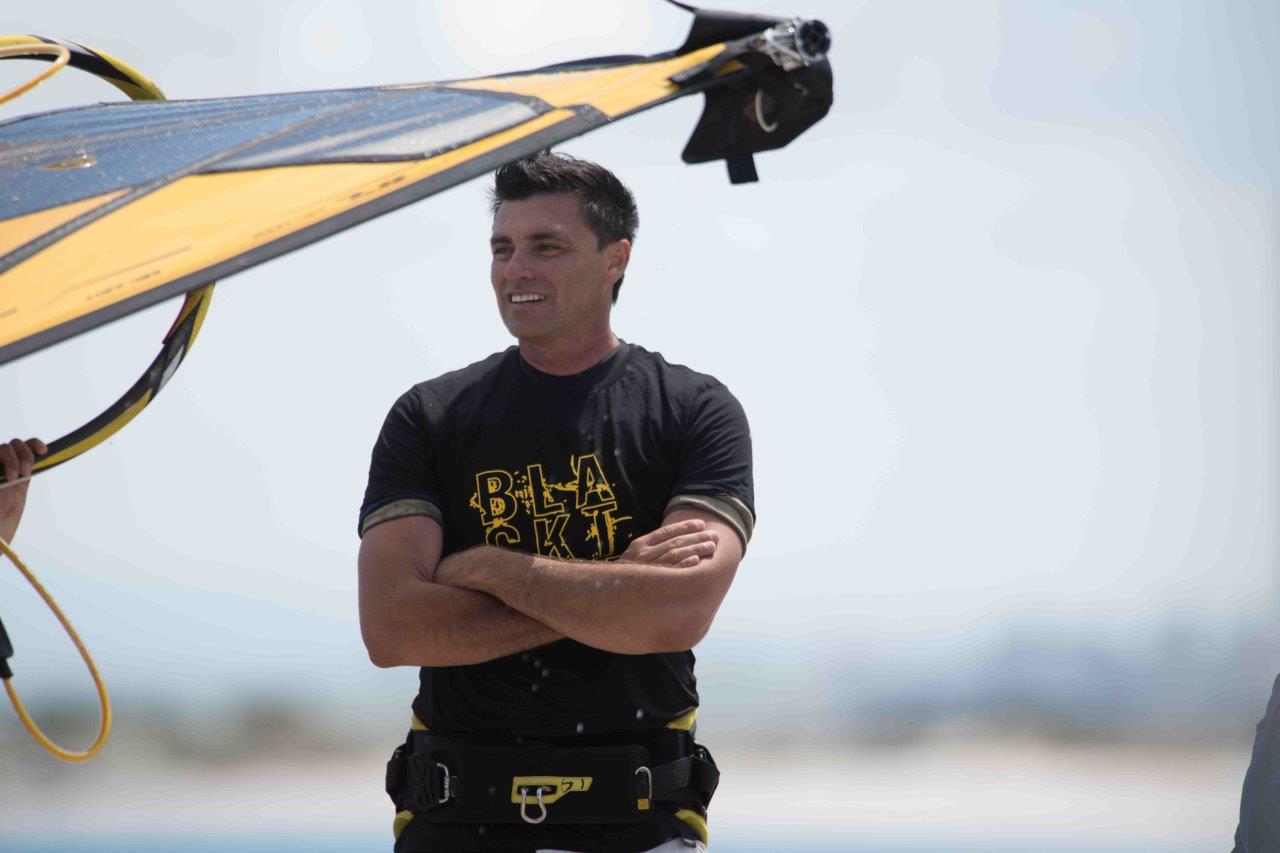- ZERO 26 – OVERVIEW
- SALTpro | PRO WAVE from €659
- SPY | FREESTYLEWAVE from €699
- SLASH | FREESTYLE from €599
- RUSH-1 | FREE SL from €689
- AC-0 | NO CAM RACE from €879
- AC-2 | 2 CAM RACE from Feb 026
- AC-3 | 3CAM RACING from €879
- AC-1 LTD | RACING from €1059
- F1 | FOIL RACING from Feb 026
- F0 | FOIL RACE NO CAM from Dic 025
- Q-BOND SAILS DETAILS
- ZERO 25 – OVERVIEW
- SALTpro | THE WAVE from €649
- SPY | FREESTYLEWAVE from €659
- SLASH | FREESTYLE from €569
- AC-F | CROSSRIDE from €639
- AC-0 | NO CAM RACE from €749
- AC-2 | 2 CAM RACE from €789
- AC-1 | RACE SERIES from €839
- F1sl | FOIL PRO RACE from €999
- F1x | FOIL NO CAM RACE from €799
- SKOOL | EASY LEARNING
- S-LINE | RENTAL SAIL
- ZERO 24 – OVERVIEW
- ZERO 23 – OVERVIEW
- ZERO 22 OVERVIEW
- ZERO 21 OVERVIEW
The man that lives to windsurf. Andrea Cucchi

He has the Black Team, joins and supports them to the events and races with them, and also his Black Sheep who he spends time to share the windsurfing lifestyle, and also to have their feedback on the gear and, but he spends most of his time running his company, Point-7.
A day not on the water is a very bad day for him, he cannot be testing the many prototypes that will make the next generation of his sails. All Point-7sails go through a strict analysis before final production.
TWH:- Your priority is to find ways to improve your sails. Is this just in sailing terms, or also the close work you do with the manufacturers for strength, durability and precision?
ANDREA:- A product can always be improved and through the product we want our clients to feel our lifestyle and soul of the company. We have on each sail line 3 important ingredients which makes a Point-7 sail. This you feel as soon as the wind kicks in the sail. Development is not about sitting in front of a pc and designing. It’s about getting on the water with good testers, feeling the product, understanding where and how to improve it, not being stubborn on feedback being received by the users and working on each detail. Designing a rig is just one of the many parts around building a good product. Precision and quality in production is one of the focus, but as well buying first class materials. All our monofilm are anti-UV and come from the US. A rig is made from different components, they must work with harmony between each other, and they come from different suppliers from more than 6 different countries. Our job is to make sure that they are safe, durable, accessible, bringing a lot of fun in their high performance, looking ‘bad ass’ as possible, and of course, at the best price.
TWH:- Everyone wants light, they look at specs and say that is lighter. They then go on the water believing the sail is lighter.
What is light for you? The weight of the sail, or the way it handles on the water.
ANDREA:- An easy way to sell the product for a retailer is to have a product to look sexy and to show that is light. If one year the boom is 4cm shorter or the mast has different length than this is also a good way to show a change in the product from year to year. Everyone can see this. The truth is on the water only. If it’s too short for people’s idea, they could say that it has no power, if it is too long, they could say that it is not good for handling. In development this can also be done without touching the boom length. Sometimes we can only comment what we see and is easy to see, but in a sail, there are so many components that can be changed and not visible to a naked eye but are exactly those which can be more influential than others. To have a light sail there is also a limit. In the past especially wave sailors were looking for strong equipment and weight was not a big issue. Then, for easy marketing light was a word which helped selling, till people realized that maybe those 100g more on a rig is not a big percentage difference and maybe is better to have them! In rig components light does not always win. A light boom might be too stiff to absorb the chop, or a light mast could be too reactive to be comfortable, and this would result in feeling heavier, while they are just stiffer in reality…but too stiff. A light sail could have the wrong shape and feel heavier than a heavier physical weight sail. Stiffness, reflex, performance is what makes a rig light, thanks to its comfort, and will allow to sail longer. We focus first in having a product which performs good on the water, later we can check if it can be made lighter and if it’s worth it for the resistance, durability and does not destroy the performance.
TWH:- There is a fine line between a secret prototype and an idea for the future that people need to see and test. The AC-Z has finally been introduced to the public, not in production form yet but still a true sail to be tried and tested.
Can you tell us a little bit about this sail?
ANDREA:- The AC-Z is a reality. We wanted to bring on the market a sail which would unite cam lovers, with cam haters. This meant producing a sail which would take out all the negative factors from a cam sail, to have the cam haters to love a cam sail, and at same time, to develop a sail that would have all advantage from a no cam sail, but even try to increase the performance of a cam sail, to convince people to let go their am-cam sails. The idea was clear of what we wanted to bring to the market, but the product to build had to be very balanced for the 2 directions, and this was a thin line. We started off with 5 different ideas, to see which way would meet best the expectation of both groups. It had to stay exactly in the middle, and the testing was super interesting as you could feel from each of the 5, the differences.
The AC-Z now results to jibe like a no cam, but it has 2 race cams under the boom.
To water start like a no cam sail, as it has no cams a small sleeve on top of the boom, which does not trap in water and make it easy even to uphaul.
To have the drive like a pure race sail as thanks to the wide point sleeve on the batten 6 (counting from the top), and a deep profile. This will allow to be amazingly efficient in lulls, and control. The outline and leach opening, battens and all racing details are there to envy and race sail.
So, what to say…a race sail performance with a no cam handling!
TWH:- You are sailing mostly prototypes. It takes time to find out how the changes made have altered the sail. Often this needs specific conditions.
What are the sail sizes that you use for your main developments? I would imagine the sizes change with each model.
ANDREA:- I normally take a sail from production and I slaughter it down to a first concept I have in mind. Sometimes the idea comes just from hearing comments on the beach, or while I take time to go for race bike relaxing training session, or when I drive for kilometres to some event. From there I get excited, and in no time, I just take a sail and start on it with scissors, staplers, duck take, paper tape and all things that allow myself to express the thought. I throw the sail on the ground and ask for support from my guys to help me to hold in place the different parts. They love it and laugh as it does not matter what everyone has to do at that moment in the office, but they need to stop and be there to help holding the idea in place. They have no idea what I’m doing, but they enjoy to slowly find out the concept I’m looking for. If I manage to put it together in that same moment, you can be sure I’m in the water after 20minutes. So, I generally work on the sizes that I know that I can use on our home spots on that same day or next. Depending for what discipline it is, it can be mainly a 7.8 if it’s a slalom sail, or a 6.5 more freeride, down to a 5.0 for waves. We have wind everyday and with different intensity according to the beach we chose, so it’s easy. Once I taste the first concept and I like it, I than chose from those sizes to do 5 samples sails, with different ideas to explore more in detail the options. After that second step, we do each size from the line, and we test each single one of them, and adapt them to the millimetre to the right mast length, boom, extension, batten displacements. Therefore, each size is developed independently in the right wind. There is no scaling of sizes, as we believe that what works in 10 knots, can be developed a little different for the size used in 40 knots. So, you practically start from one size to understand the direction you want to go, but than you need to do the work on each size. I personally like to be sure that I’ve been on the water with each size, as I want to know what we give to our clients exactly. The only sail I can’t test is the kids sail, but for this we have Russell Groves! but just like on each dedicated model, we have a pro of that discipline taking the product to the extreme. Only when put under the right extreme pressure you can feel even further where to modify.
TWH:- TheBlack Team are very happy with their 2019 sails; results are showing it.
When will they start to get 2020 prototypes for testing?
ANDREA:- It’s practically all done since April. The team is mainly working on the sail they use. The team needs to focus on their competitions and the model sails they use. So Yentel and Taty are full on testing and giving feedback on the Slash, Josep Pons received 6 different concepts of sails to test this winter for the Salt Pro, and myself in the winter I focus testing mainly the freeride and free race sails. I take long time on them myself as these are very important. These are the sails we mainly sell to our public to enjoy their free-time, holidays, weekends and they need to be perfect in each size. Pro-riders don’t have time and don’t want to focus on these sails as they have other priorities, so I’m very happy to do this myself and bring into the development my friends who use these sails every day for fun. For the race sail, like the AC-One, we normally test these in the end of spring. It’s a bit late to do as it gets stress for the deadline but is also the best moment. The riders have had the sails for the winter, their first races, so they will only start to give a good feedback at this time. Testing in the winter the freeride\free race sails, gives more ideas as well, so this accelerate the development of the AC-One, even if we need to do it in a shorter period. You cannot re-start development the day you have put a sail in production, otherwise it would mean that you were not happy of what was decided. I generally prepare new sails, test them myself with my local racing friends, work on it to the mm, and when I think I’m ready to surprise my Point-7 Black Racing team, I give them to them to say YES or NO. What I really need from them is to confirm what I know already and be sure that they can agree that is better. We than meet at the events and put done last things to do before having them produced in production. Best riders are not always the best testers, and this is in a lot of sports.
TWH:- Lake Garda is the perfect location for you to have your base. The wind conditions allow you to spend time both on the water and in the office. Often giving you a nice early morning session on the water and then in the office for 11am. The perfect life.
However, it is your job, testing is not just done in perfect conditions. How do you get your motivation to test in those not so pleasant conditions?
ANDREA:- Well lake garda is the gym of windsurfing. You know the wind kicks in from 5.30am to 10am in the morning and is only worth going if its 16knots to 40knots. Then the wind kicks in again in the afternoon, 15km from the morning spot, and it’s between 10 to 22 knots from 1pm to 5pm. This way you can easily plan your daily schedule. In the summer I wake up around 5.30am, do an hour of emails, which I need to do to be more relaxed after, and at 7am I’m on the water till 9am testing. I live 500m from the morning spot, so I don’t lose any time driving to the spot. After sailing I chose to either go to do the office work at home, or to meet up the rest of the team in the office for meetings and project. The office is also only 2km’s from the afternoon spot, so I go on the water from 13.30 to 16.00 if I really have to test something, or do one or two hours of alternative sport if I have a window sometimes during the week, instead of having a lunch break, otherwise I keep working. If I windsurf in the morning, I generally try not to have the second session in the afternoon, and vice a versa. Depends how much there is to do on the water. Sometimes we have weeks where we don’t have time to do the office work but need to stay rigging 30 sails in one day to test on the water. These are long hours and tiring days. I hardly windsurf with my own racing sail and tune my personal gear. I always have something new to test in my hands, and when I windsurf, it’s for testing and I’m lucky to enjoy this a lot. Only few times I manage to just grab my gear and go for a couple of hours blasting around the beautiful scenery that our home spot delivers. It’s more like one km one side, one km other side, back to the beach, modify, back to the water. Rig, de-rig, multiple times.
The winter is the hard bit. We have wind only in the morning from 7am to 1pm and we don’t have more than 10degrees. So work in the morning from early hours to 9am, and then I have a couple of hours to go testing with gloves, shoes, thick wetsuit, neoprene masks, but this lake is so special and practical for testing, that it’s still perfect to do what we need to do.
TWH:- There is a time where a prototype must go into production.
What makes that choice for you? Time/Date? This sail is awesome, it must go on the market. Or it is a progression, a plan?
ANDREA:- We are having a deadline to be ready with all our materials which we only order from the US. We have a deadline to be ready with all the samples to be checked in all the sizes in production. So, time and date are what decides. The decision is what to do, but it’s not deciding…this is what we did till now, so it will go in production.
Once all decided has to enter production, we fly to the production facility, rig each size from each model, where we check the graphics, the details, the profile, leach, batten and cam rotation, and all what we need to make sure is needed to make it perfect. We still do last changes directly there if we see that we can still improve that extra millimetre, and so it’s not rigging once each size, but it can be even more time. It’s hard work. Last time I was there, on the way back I even lost my plane, as I felt asleep at the boarding gate! The guys in production sent me a photo of them in the evening, sitting down looking destroyed drinking beers to relax. We generally don’t put a product in production if it’s not ready or we are not happy. Even if we made improved changes, but we are not yet satisfied with it at 100%, we prefer to delay the presentation of the sail on the market or keep working on it for the year after.
TWH:- ThanksANDREA. Your sails show your dedication.







